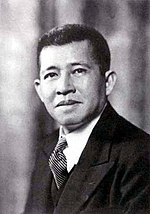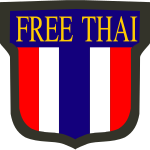Seri Thai movement
The Seri Thai Movement ( Thai : ขบวนการ เสรีไทย , RTGS : Khabuan Kan Seri Thai; translated "Free Thai" or "Free Thailand"; English Free Thai Movement ) was a national resistance movement against the actual occupation of Thailand by Japanese forces during the Second World War I and the collaboration of the Thai government with them. It was active from 1943.
structure


The movement was made up of civil and military officials. It was led by the liberal politician and then crown regent Pridi Phanomyong . Outside Thailand, the movement also had sections in the United States and Europe, particularly in England, where Thai students in particular supported the goals of the resistance. The then ambassador to Washington and later Prime Minister Seni Pramoj headed the American wing of the organization . It had about 90 members and worked closely with the US Foreign Intelligence Office of Strategic Services (OSS). Few of them were smuggled into Thailand. The English group had 54 members, 37 of whom joined the British Army . A few of them were trained as paratroopers and then jumped over Thailand.
resistance
The Seri Thai movement rejected Thailand's entry into the war on the side of the Japanese and instead wanted to work with the Allies. Pridi, who represented the underage King Ananda Mahidol as one of three regency councils , refused to sign the declaration of war on the United States. And Ambassador Seni refused to deliver it to the US government because, in his opinion, it was not covered by the true will of the Thai people and he considered it invalid without Pridi's signature.
By mid-1944, the Seri Thai movement succeeded in filling important positions in politics, the military and business with its own people. Prime Minister Plaek Phibunsongkhram , who externally worked with the Japanese, tolerated the movement and did not extradite it to the Japanese. The Thai secret service chief Adun Adundetcharat , who belonged to the Seri Thai network, actively cooperated with the allies, in particular with the American secret service OSS. Adun did not extradite OSS agents captured in Thailand to the Japanese, but took them into custody himself and protected them in this way.
End of the occupation and takeover of government
In July 1944, the Seri Thai forces were able to urge Prime Minister Phibunsongkhram to resign and replace them with Khuang Aphaiwong, who was close to them . Under him the de facto occupation of Thailand by Japan could be ended. After the surrender of Japan, Seri Thai member Thawi Bunyaket became interim prime minister on September 1, 1945 . Shortly afterwards, Seni Pramoj, who had returned from Washington, took over the government.
literature
- Free Thai. Personal Recollections and Official Documents. Edited by Wimon Wiriyawit. White Lotus Press, Bangkok 1997, ISBN 974-849-690-2 .
- Volker Grabowsky : Small history of Thailand. CH Beck, Munich 2010, ISBN 978-3-406-60129-3 .
- John B. Haseman: The Thai Resistance Movement During World War II. Silkworm Books, Chiang Mai, 2002, ISBN 974-7551-62-4 .
- Direck Jayanama: Thailand in World War II. From the outbreak of war in Europe to Hiroshima. A document of contemporary Asian history. Erdmann, 1970, ISBN 3-7711-0113-1
- Sorasak Ngamcachonkulkid: Free Thai. The New History of the Seri Thai Movement. Institute of Asian Studies, Bangkok 2010, ISBN 978-616-551-191-9 .
- E. Bruce Reynolds: Thailand's Secret War. OSS, SOE and the Free Thai Underground During World War II. Cambridge University Press, 2005, ISBN 0-521-83601-8
